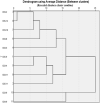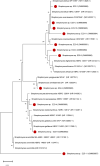Antimicrobial and antioxidant activities of Streptomyces species from soils of three different cold sites in the Fez-Meknes region Morocco
- PMID: 36241756
- PMCID: PMC9568536
- DOI: 10.1038/s41598-022-21644-z
Antimicrobial and antioxidant activities of Streptomyces species from soils of three different cold sites in the Fez-Meknes region Morocco
Abstract
The increasing demand for new bioactive compounds to combat the evolution of multi-drug resistance (MDR) requires research on microorganisms in different environments in order to identify new potent molecules. In this study, initial screening regarding the antimicrobial activity of 44 Actinomycetes isolates isolated from three soil samples from three different extremely cold sites in Morocco was carried out. Primary and secondary screening were performed against Candida albicans ATCC 60,193, Escherichia coli ATCC 25,922, Staphylococcus aureus ATCC 25,923, Bacillus cereus ATCC 14,579, other clinical MDR bacteria, and thirteen phytopathogenic fungi. Based on the results obtained, 11 active isolates were selected for further study. The 11microbial isolates were identified based on morphological and biochemical characters and their molecular identification was performed using 16S rRNA sequence homology. The UV-visible analysis of dichloromethane extracts of the five Streptomyces sp. Strains that showed high antimicrobial and antioxidant (ABTS 35.8% and DPPH 25.6%) activities revealed the absence of polyene molecules. GC-MS analysis of the dichloromethane extract of E23-4 as the most active strain revealed the presence of 21 volatile compounds including Pyrrolopyrazine (98%) and Benzeneacetic acid (90%). In conclusion, we studied the isolation of new Streptomyces strains to produce new compounds with antimicrobial and antioxidant activities in a cold and microbiologically unexplored region of Morocco. Furthermore, this study has demonstrated a significant (P < 0.0001) positive correlation between total phenolic and flavonoid contents and antioxidant capacity, paving the way for the further characterization of these Streptomyces sp. isolates for their optimal use for anticancer, antioxidant, and antimicrobial purposes.
© 2022. The Author(s).
Conflict of interest statement
The authors declare no competing interests.
Figures












References
-
- Rudi Emerson de Lima Procópioa, Ingrid Reis da Silvaa, Mayra Kassawara Martinsa, João Lúcio de Azevedoa, J. M. de A. Antibiotics produced by Streptomyces. Brazilian J. Infect. Dis.16, 466–471 (2012). - PubMed
MeSH terms
Substances
LinkOut - more resources
Full Text Sources
Molecular Biology Databases
Miscellaneous

